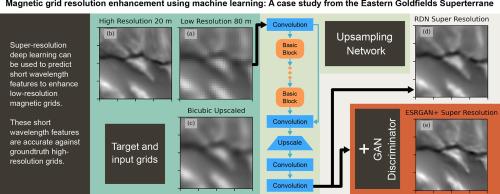Ore Geology Reviews ( IF 3.2 ) Pub Date : 2022-09-22 , DOI: 10.1016/j.oregeorev.2022.105119 Luke Smith , Tom Horrocks , Eun-Jung Holden , Daniel Wedge , Naveed Akhtar

|
Densely sampled geophysical surveys are a key driver for mineral exploration, but sample density, and therefore grid resolution, is limited by survey cost. Consequently, computational methods are resorted to for upsampling, or ‘super-resolving’, of gridded geophysical survey data. However, existing approaches such as interpolation filters do not leverage high-resolution detail from pre-existing geophysical surveys. Through the application of state-of-the-art deep learning super-resolution architectures, accurate high-resolution grids are predicted from corresponding low-resolution grid priors. Specifically, the RDN and ESRGAN+ neural network architectures, which were originally developed for enhancing images, are applied to enhance magnetic surveys and trained with high-resolution and low-resolution magnetic grids of the same extent. 80 m cell size magnetic grids are upsampled to 20 m cell size using this method, and predicted value and structural accuracy comparisons to the corresponding ground truth 20 m grids are presented over two test sites in the Eastern Goldfields Superterrane, Western Australia. The method based on RDN achieves 53 % lower error compared to Bicubic interpolation. The case study demonstrates that the deep learning approach can improve the resolution and frequency content of geophysical surveys without requiring additional sampling expense, while remaining accurate against known ground truth surveys. Super-resolution may assist in the interpretation of low-resolution survey grids, however these upsampled grids cannot perfectly recreate the accuracy of highly sampled surveys gridded at their optimal cell size.
中文翻译:

使用机器学习增强磁网格分辨率:东部金矿超地层的案例研究
密集采样的地球物理调查是矿产勘探的关键驱动力,但样本密度以及因此的网格分辨率受到调查成本的限制。因此,采用计算方法对网格化地球物理调查数据进行上采样或“超分辨”。然而,现有的方法(如插值滤波器)没有利用来自预先存在的地球物理调查的高分辨率细节。通过应用最先进的深度学习超分辨率架构,从相应的低分辨率网格先验预测准确的高分辨率网格。具体来说,RDN和ESRGAN+ 神经网络架构最初是为增强图像而开发的,用于增强磁测量,并使用相同程度的高分辨率和低分辨率磁网格进行训练。使用该方法将 80 m 网格大小的磁网格上采样到 20 m 网格大小,并在西澳大利亚东部金矿超地层的两个测试地点提供了与相应地面实况 20 m 网格的预测值和结构精度比较。基于RDN的方法与双三次插值相比,误差降低了 53%。案例研究表明,深度学习方法可以提高地球物理调查的分辨率和频率内容,而无需额外的采样费用,同时保持与已知地面实况调查的准确性。超分辨率可能有助于解释低分辨率调查网格,但是这些上采样网格不能完美地重现以最佳像元大小网格化的高采样调查的准确性。











































 京公网安备 11010802027423号
京公网安备 11010802027423号